The potters of Gouda 1570-1940 and their significance for the history of Dutch ceramics
Author:
Don Duco
Original Title:
Boekbespreking: De pottenbakkers van Gouda 1570-1940 en hun betekenis voor de geschiedenis van de Nederlandse keramiek
Publication Year:
2012
Publisher:
Pijpenkabinet Foundation
Journal:
Nieuwsbrief Pijpenkabinet
Description:
Book review of the publication by Adri van der Meulen and Paul Smeele about the Gouda pottery industry and their products.
The most recent publication by the writer duo Van der Meulen and Smeele has become the jewel in their research into Dutch ceramic companies. After the Brabant potters already got their attention in the 1980s, these passionate ceramic collectors conducted research into various Dutch production centers over several centuries. From the Frisian kerf-cut earthenware to a modern pottery such as the Adco, they made a publication in book form. Yet their passion clearly lies with the utility pottery and this is certainly proved with this voluminous and richly illustrated book.
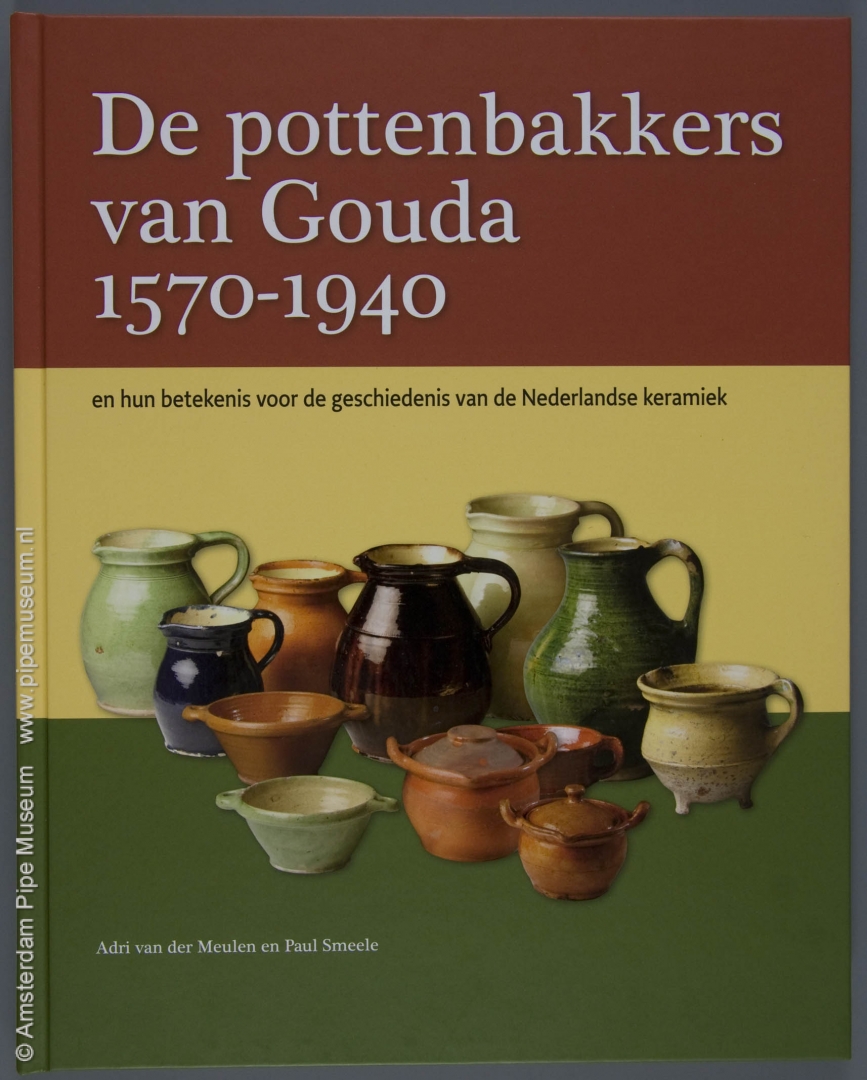
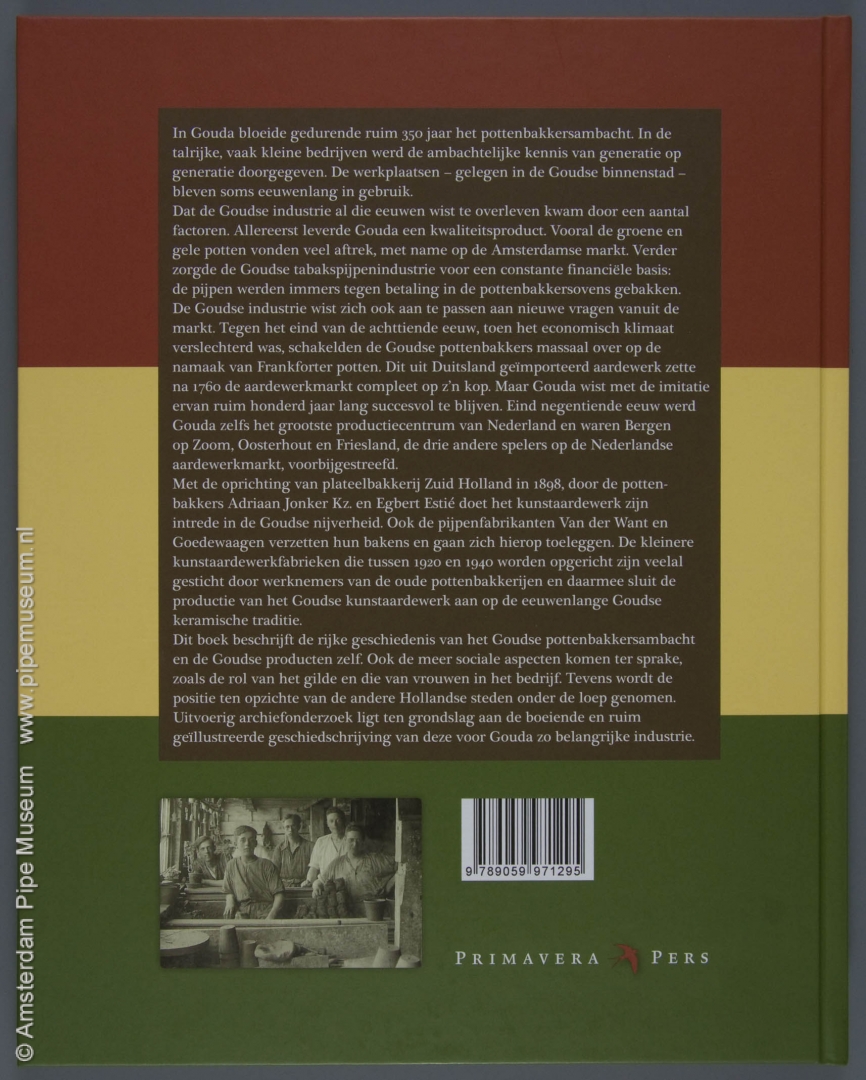
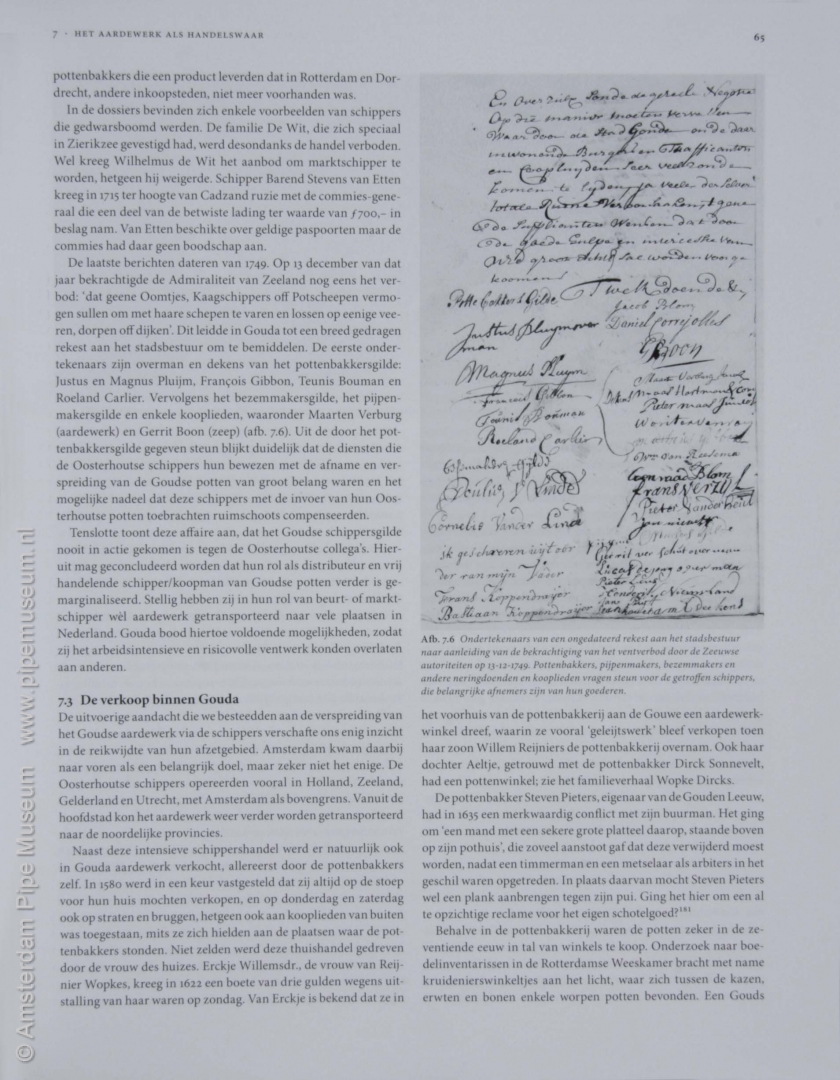
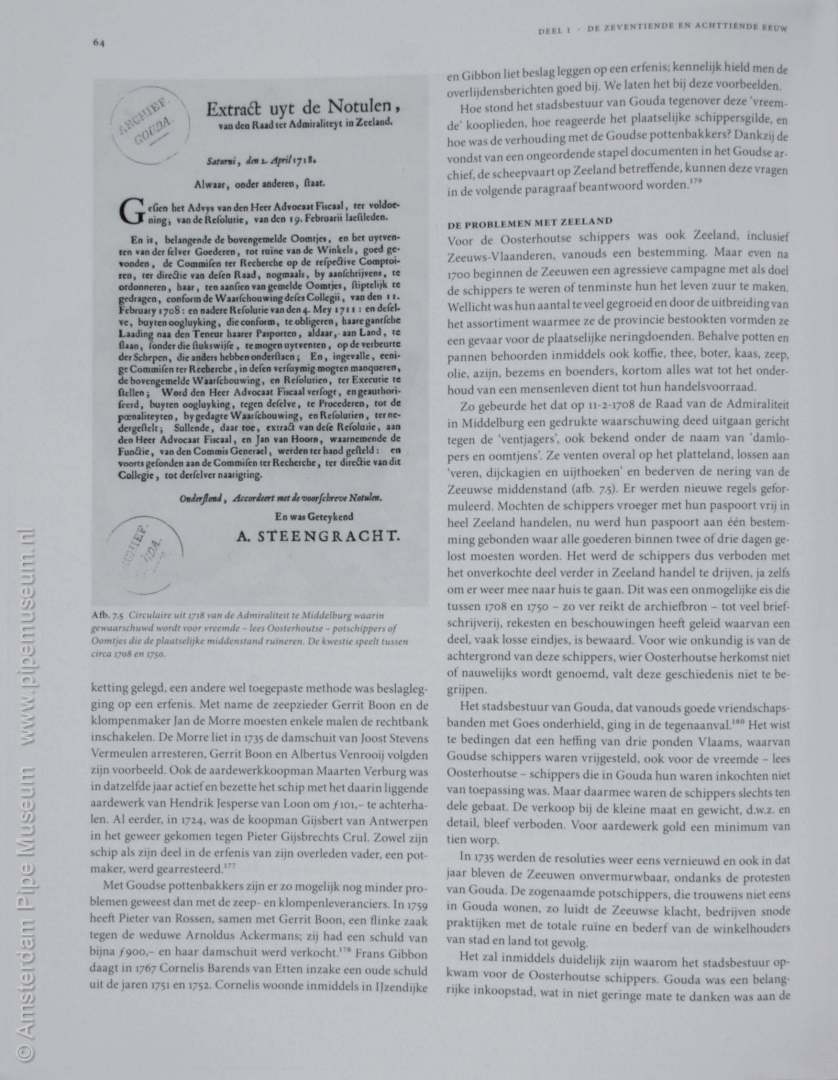
The new publication is divided into three periods and each period starts quite unusually with a chapter introducing the potters as persons. In these personal introductions you will become acquainted with the protagonists of the Gouda pottery industry. You get to know their actions up close and experience the almost oppressive family ties. In their research, the authors have not overlooked anything, they can even determine that a particular potter was almost blind. As you read, a web of knowledge about the families in this specific industry unfolds, fascinating and faceted to the maximum. This journey of fortunes outlines the historical context of the Gouda workshops. It not only shows who these people were and how they worked, but also reveals the simplicity of the industry, including the trading structure. Because the Gouda potter adapts to changing circumstances, often just before it was too late, history was written over nearly four centuries. For the sake of readability, certain specific knowledge has been brought together in statues, such as the phenomenon of kiln stones and its deliveries or the pattern of marriages and remarriages.
The remaining chapters deal with the factories and their products. Initially, the Gouda potteries were relatively small workshops where the craft knowledge was passed on from generation to generation, occasionally alternated by an investor. The companies were located in the Gouda city center with the Raam as the main canal. The continuity of these potteries was initially guaranteed by the income of the pipe maker bosses who had their pots with pipes baked there. In addition, a quality article was created for domestic use. This pottery was subject to a high degree of standardization in both form and design and the production volume was soon supra-regional. Shipping took place mainly to Amsterdam. Until 1630, the Gouda product was predominantly made of green lead glaze. Earthenware in yellow and green was then supplied to produce predominantly yellow ware in the eighteenth century. Some companies specialized in industrial pottery, first pipe pots and later ceramics for confectioners.
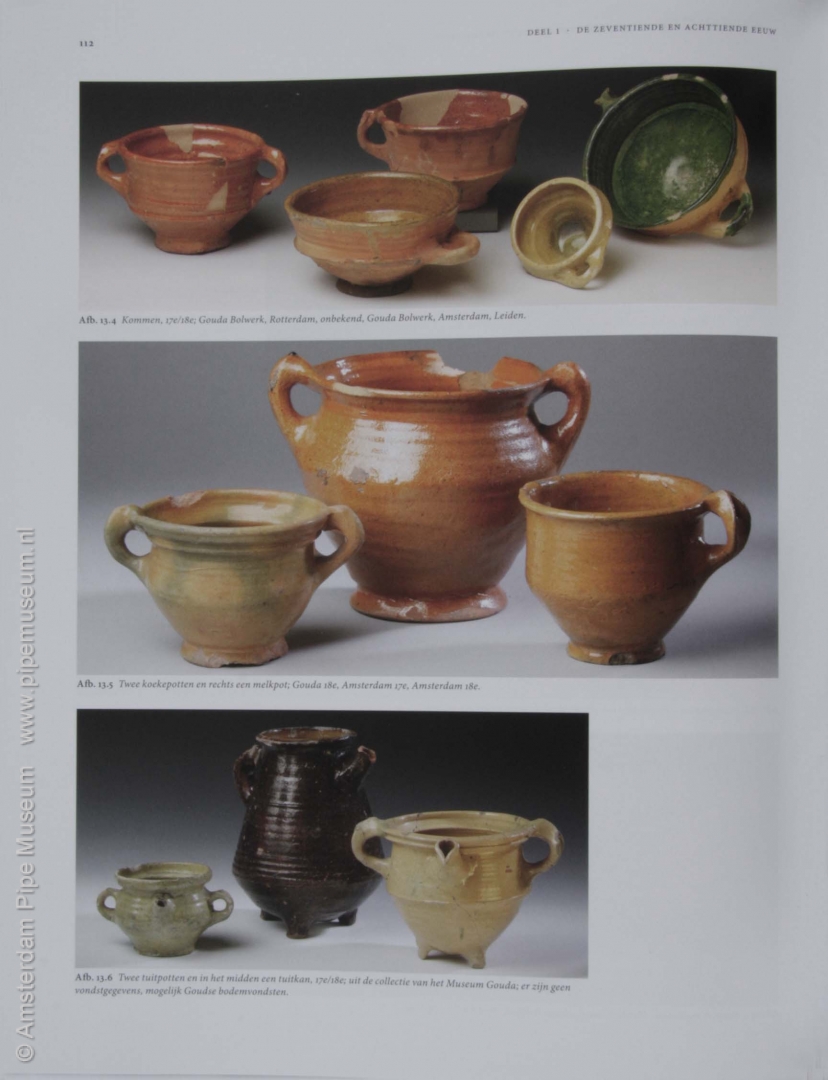
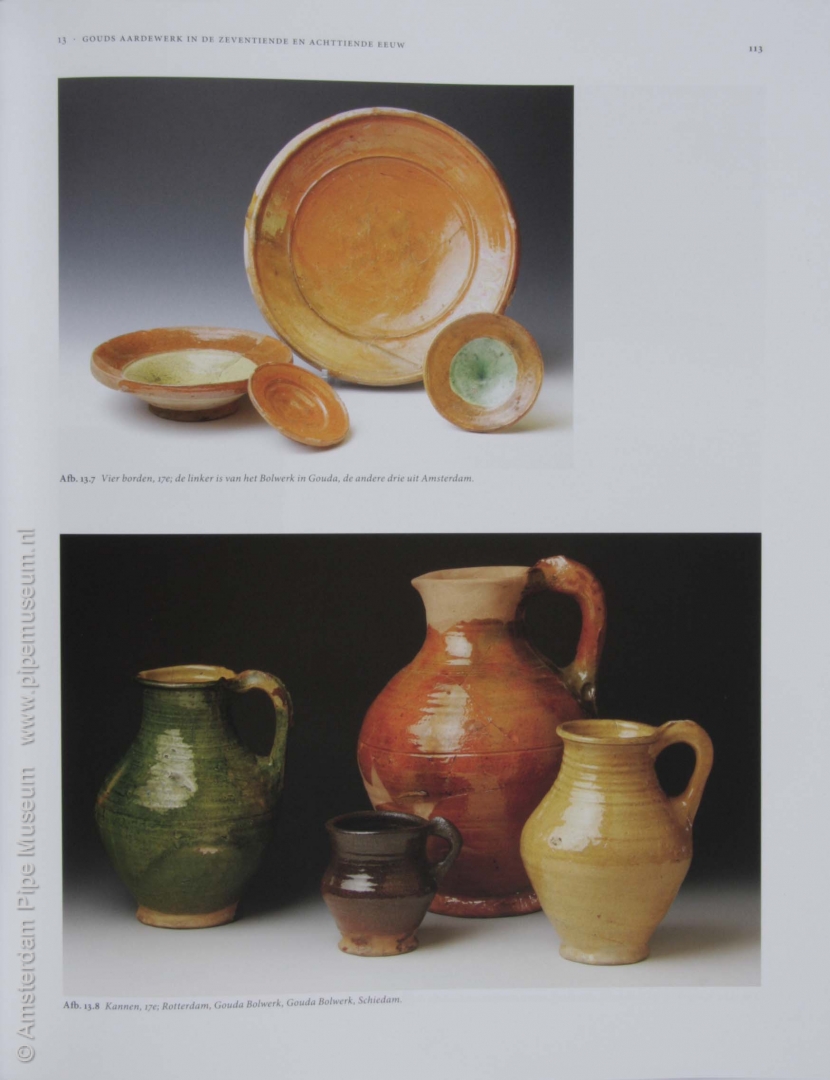
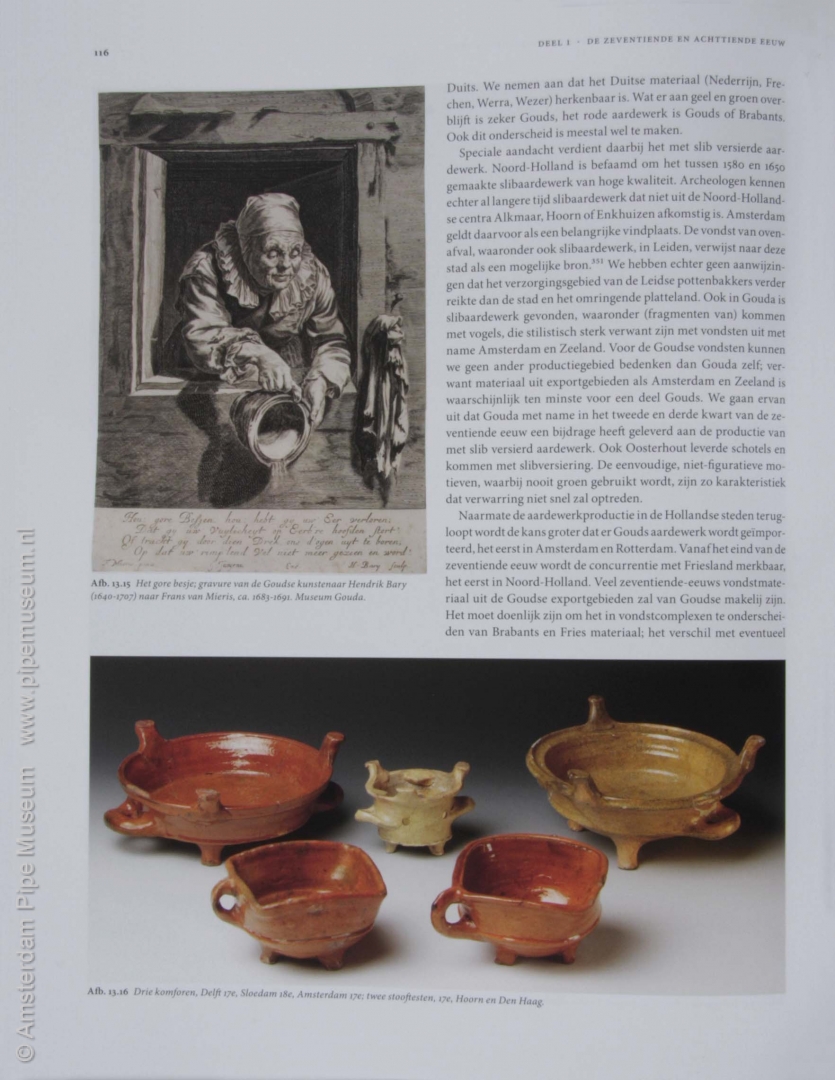
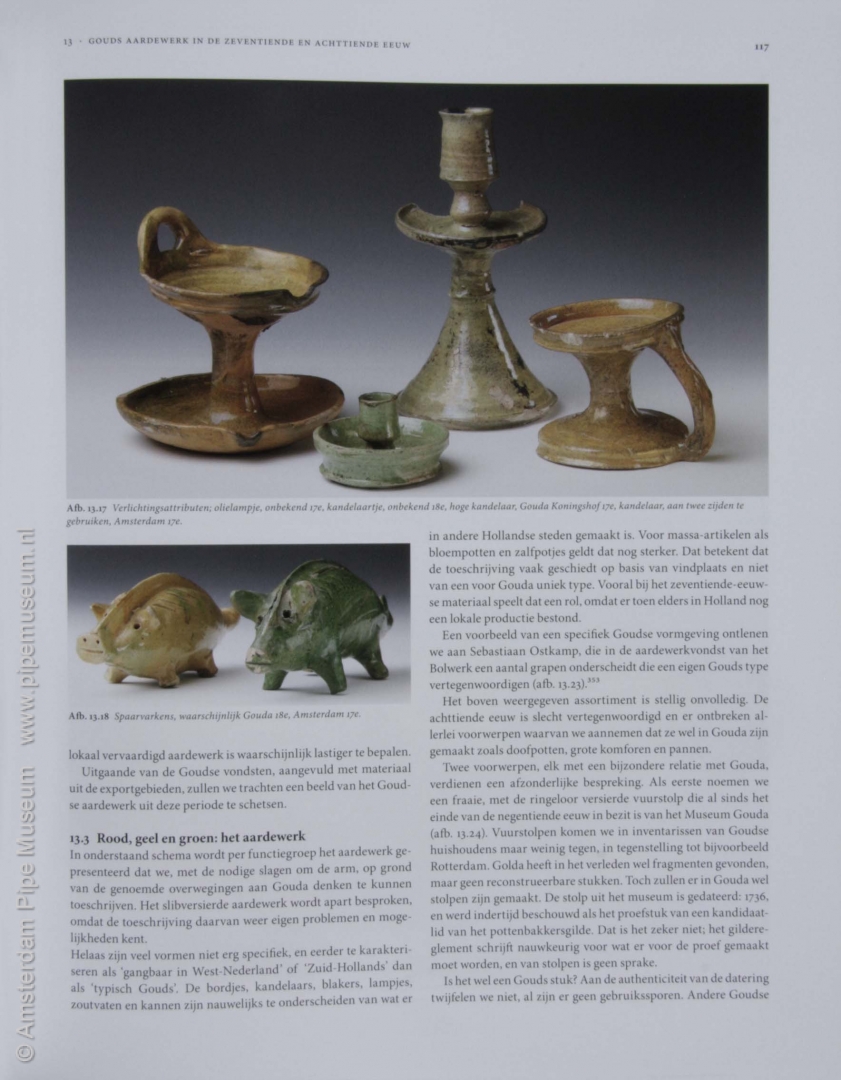
The authors know how to distil a surprising amount of information from the archives and are therefore able to clearly interpret the history of Gouda ceramics and place it in a broad context. Themes such as choice of location, workplace layout and tools and materials used are discussed. In addition, they indicate the role of the potters' guild, founded in 1683, and outline how that corporation brought an egalitarian tendency with equal opportunities for everyone. The economy of the industry is also discussed, such as the introduction of the complaint that ensured that if stocks were too large in a particular company, deliveries were also made from there. This was partly possible because the product was highly standardized. In this way, the Gouwenaars were able to guarantee fast delivery while there was no price loss. Social aspects, such as the position of women in this industry and the relationship between boss and servant, also play a role in the argument.
In the first part of the book the image establishes itself, in part two the refinement slowly resonates. Since a lot of archival research has been done, combined with a sharp look at the existing sources, the approach is always cross-border. This is further reinforced because the research is anchored in the Dutch pottery industry in general, as is also apparent from the subtitle of the book. For example, a petition from the potters in Holland is the starting point to compare the position of Gouda with other centers and to outline and interpret the local businesses. Naturally, this always takes place in the light of the two other major centers: Friesland and the towns Oosterhout and Bergen op Zoom in Brabant. Every starting point is selected ad fundum and formulated clearly.
It is precisely in the national comparison that the exceptional position of the Gouda pottery industry appears. In this way a fascinating web of economic patterns develops that spreads throughout the Netherlands. This image is rooted in the tension between supply and demand, range of models and use, and trade facilities and barriers. Incidentally, the story is not limited to industry and its products alone, but is even anchored in skippers and merchants. A perfect synthesis therefore between the archival material and the other sources in a clear speaking language, staccato, without nagging, honest and open in what is not yet familiar with inevitably a critical note to existing publications here and there.
Besides the original fortunes and the historical line of the industry, there is the product itself. As connoisseurs of pottery from all regions, the authors are better able to interpret this material and to link the archival data to the material in a unique and clear manner. In this way they arrive at clear job descriptions and a useful period dating. Despite the existence of the generic name Gouda pottery, hardly anything was known about the Gouda product itself. The archaeologist did not distinguish a Gouda product from potter's goods from other Dutch cities such as Leiden, Rotterdam or Amsterdam. This gap has been accurately filled with this publication. From now on, the archaeologist can identify his finds more precisely by use, origin and date.
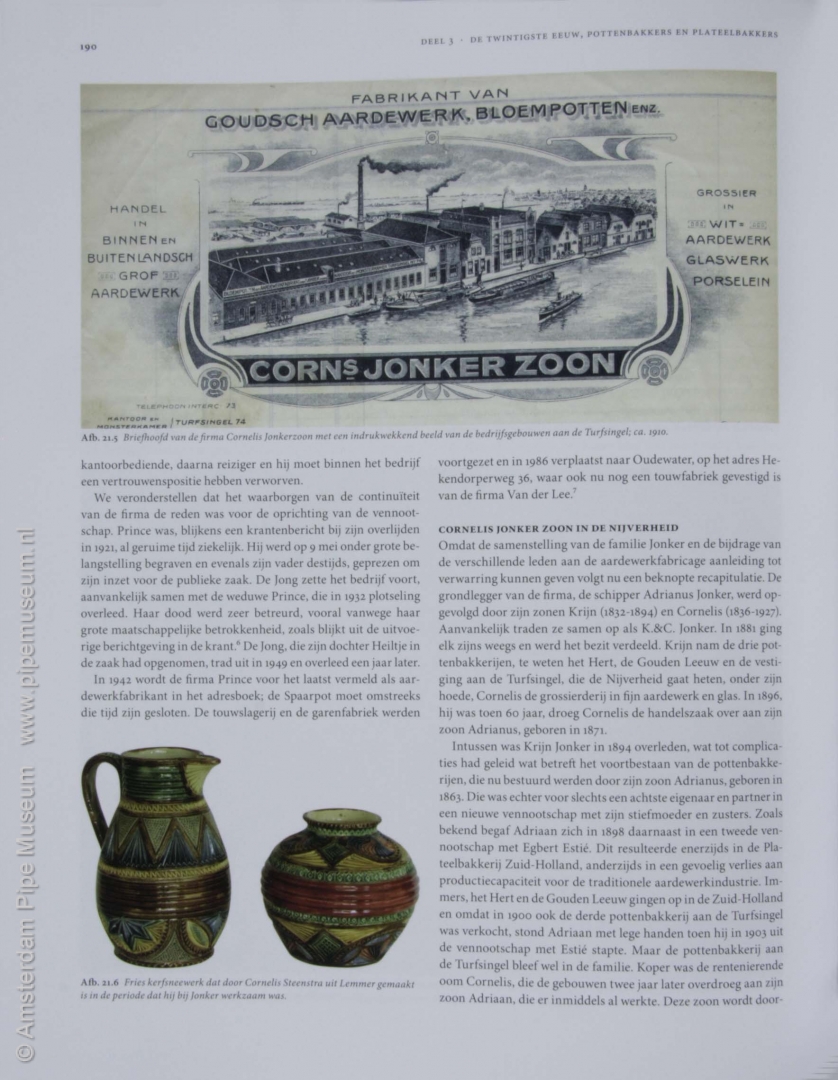
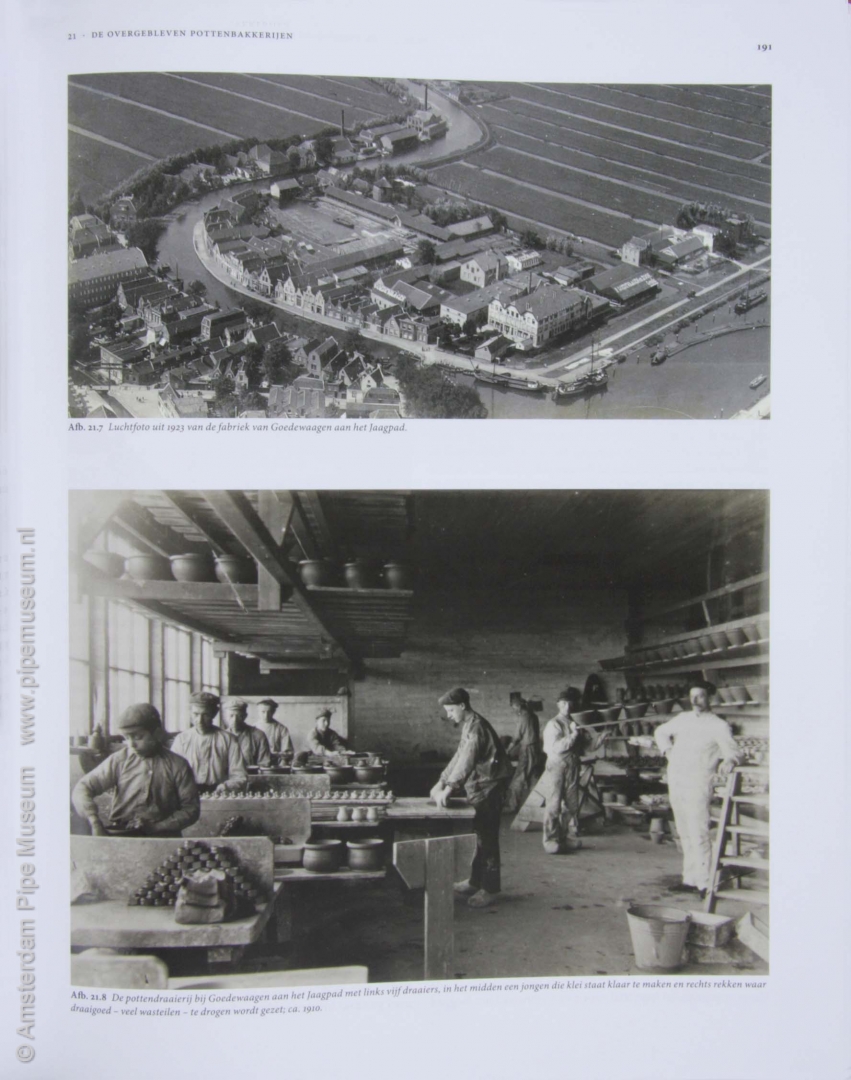
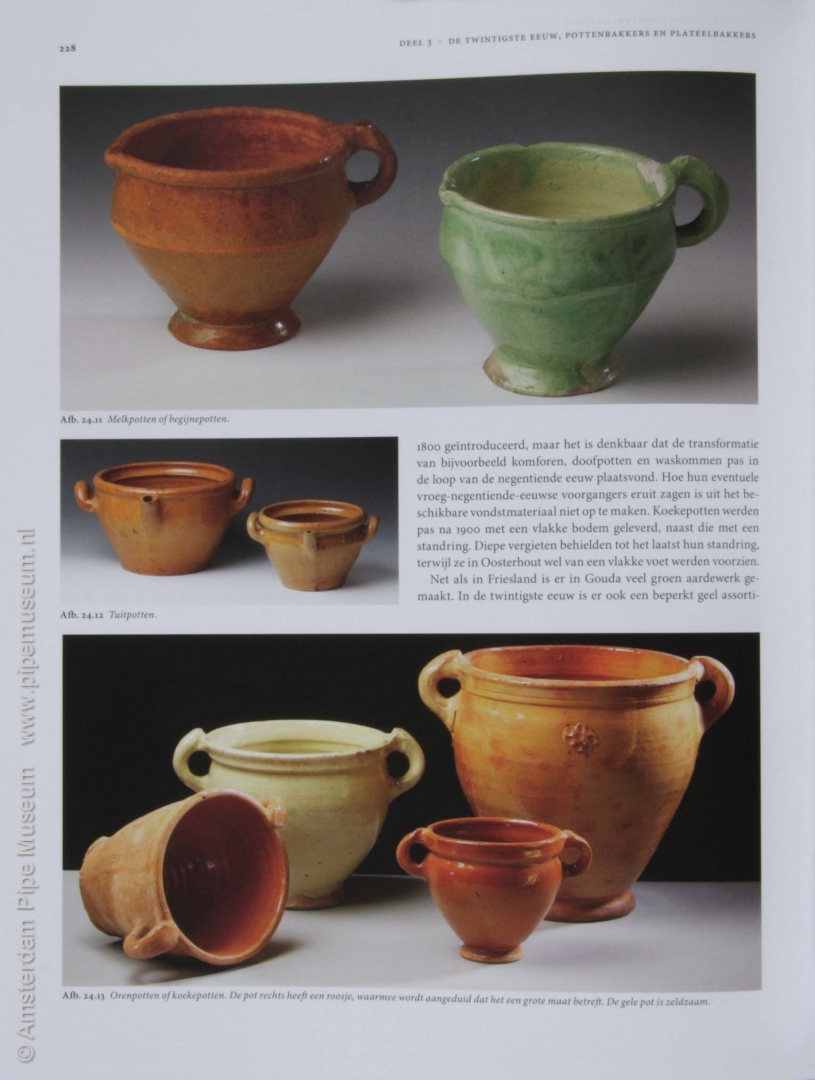
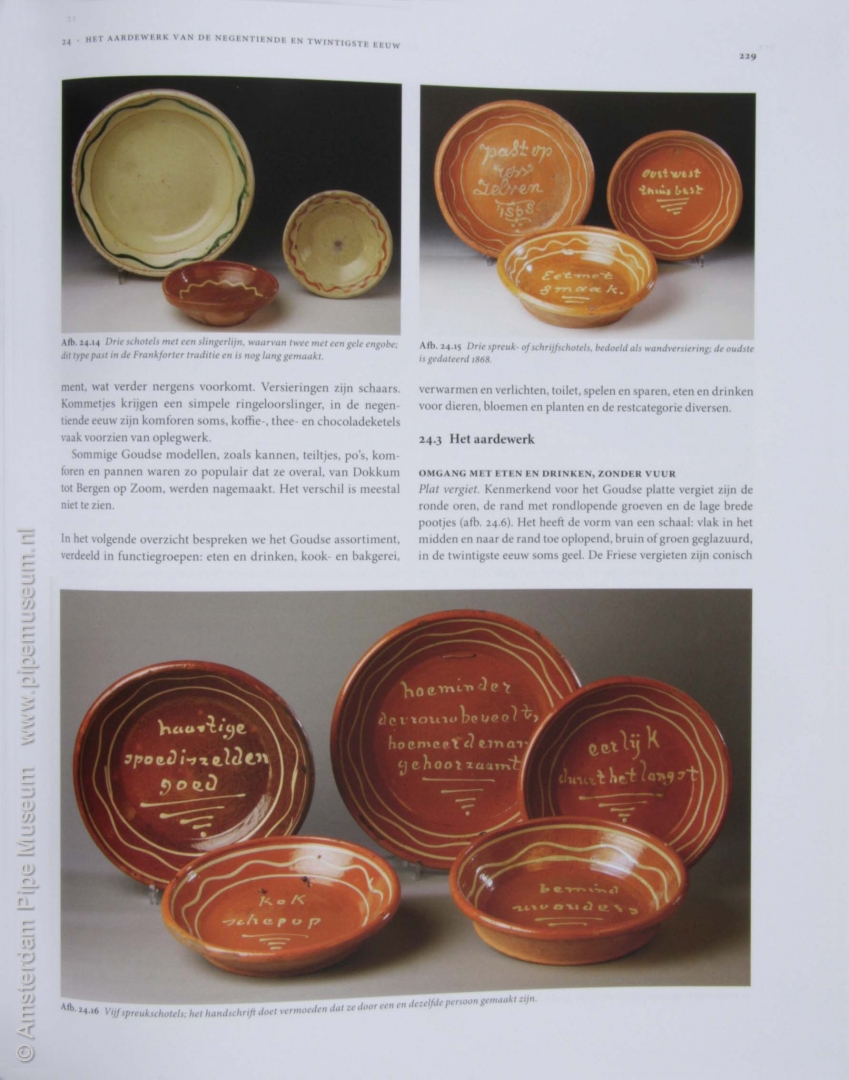
An important change in Dutch everyday pottery comes in the second half of the eighteenth century with the import of kitchenware from Germany, known as Frankfurt pottery. Frankfort's good is easy to handle baking and cooking utensils with a flat bottom and band ears. Frankforter pottery is positive for the consumer because it is sturdy and does not let grease through. The product is easy to make and the Gouda potters imitate this on a large scale and that appears to be their rescue. With this expansion, Gouda is also adding fire-burning pottery for cooking and baking to the production line. This transition overcomes the decline of the pipe industry that manifested itself from the end of the eighteenth century. The forms of the Frankforts are so fully integrated in Gouda that from 1870 onwards people speak of Gouda pottery again and the German origin has been completely forgotten.
The third part of the book is the foundation of the twentieth century Gouda fine pottery industry and also offers numerous new points of view. At the end of the nineteenth century, Gouda was the largest production center in the Netherlands. With the foundation of the Plateelbakkerij Zuid-Holland in 1898, the art pottery made its entry into the Gouda industry. The traditional product is then referred to as coarse earthenware as opposed to the fine earthenware of which the Gouda pottery is the first type. Gouda pottery turns out to be the final piece of the Gouda pottery industry, not the beginning as stated by so many authors. Van der Meulen and Smeele also provide new insights on this matter. En passant even the history of Brantjes in Purmerend is rewritten, while the transition from the pipe factories Van der Want and Goedewaagen to fully fledged ceramic companies is also explained. The smaller art pottery factories that were established between 1920 and 1940 were often founded by employees of the old potteries and even so the production of the Gouda art pottery connects seamlessly with the centuries-long Gouda ceramic tradition.
In short, the standard work The potters of Gouda reveals the complicated structure of a local industry that achieved a supra-regional appearance. By examining the history of the Gouda potteries over more than three centuries, a discussion arose about the specifics of their products and a completely new picture was formed. The authors Van der Meulen and Smeele present this insight on the basis of an in-depth source research in addition to extensive material studies. Their critical, unbound way of looking leads to the refutation of a lot of knowledge. Something like that is only possible if you are very well versed in a field and that is without doubt the case here. Due to its intricate treatment, this book has reached the level of a dissertation. After reading De potters van Gouda, you can never look at a piece of pottery again without hesitation. The book cannot be read in a single breath, it is too bulky for that, but anyone who embarks on the journey through the companies and learns to see what was achieved there will have a different view on this matter forever.
© Don Duco, Pijpenkabinet Foundation, Amsterdam - Holland, 2012.